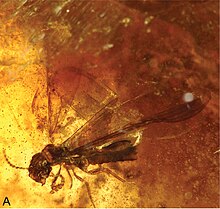
Back أرضيات (فصيلة) Arabic ارضيات ARZ Termitidae CEB Termitidae Spanish موریانگان Persian Termitidae French Termitidae Hungarian Termitidae ID Termitidae Malay Termitidae Dutch
| Termitidae | |
|---|---|

| |
| Nanotermes isaacae in Cambay amber. | |
| Scientific classification | |
| Domain: | Eukaryota |
| Kingdom: | Animalia |
| Phylum: | Arthropoda |
| Class: | Insecta |
| Order: | Blattodea |
| Infraorder: | Isoptera |
| Nanorder: | Neoisoptera |
| Family: | Termitidae Latreille, 1802 |
| Subfamilies | |
|
See text | |
Termitidae is the largest family of termites consisting of 2,105 described species of which are commonly known as the higher termites.[1] They are evolutionarily the most specialised termite group, with their highly compartmentalized hindgut lacking the flagellated protozoans common to "lower termites", which are instead replaced by bacteria and archaea. Whereas lower termites are restricted mostly to woody tissue, higher termites have diverse diets consisting of wood, grass, leaf litter, fungi, lichen, faeces, humus and soil.[2][3] Around 60% of species rely on soil-feeding alone.[4]
- ^ Constantino, Reginaldo. "Termite Database".
- ^ Ni, Jinfeng; Tokuda, Gaku (November 2013). "Lignocellulose-degrading enzymes from termites and their symbiotic microbiota". Biotechnology Advances. 31 (6): 838–850. doi:10.1016/j.biotechadv.2013.04.005. ISSN 0734-9750. PMID 23623853.
- ^ Breznak JA, Brune A. 1994. Role of microorganisms in the digestion of lignocellulose by termites. Annual Review of Entomology 39(1):453–487
- ^ Josens, Guy; Makatia Wango, Solange (2019-02-01). "Niche Differentiation between Two Sympatric Cubitermes Species (Isoptera, Termitidae, Cubitermitinae) Revealed by Stable C and N Isotopes". Insects. 10 (2): 38. doi:10.3390/insects10020038. ISSN 2075-4450. PMC 6409928. PMID 30717082.
© MMXXIII Rich X Search. We shall prevail. All rights reserved. Rich X Search